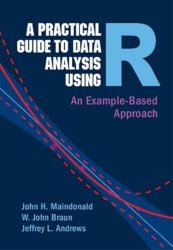A Practical Guide to Data Analysis Using R: An Example-Based Approach
- Добавил: literator
- Дата: 11-05-2024, 18:03
- Комментариев: 0
 Название: A Practical Guide to Data Analysis Using R: An Example-Based Approach
Название: A Practical Guide to Data Analysis Using R: An Example-Based ApproachАвтор: John H. Maindonald, W. John Braun, Jeffrey L. Andrews
Издательство: Cambridge University Press
Год: 2024
Страниц: 551
Язык: английский
Формат: pdf
Размер: 15.9 MB
Using diverse real-world examples, this text examines what models used for data analysis mean in a specific research context. What assumptions underlie analyses, and how can you check them? Building on the successful 'Data Analysis and Graphics Using R,' 3rd edition, it expands upon topics including cluster analysis, exponential time series, matching, seasonality, and resampling approaches. An extended look at p-values leads to an exploration of replicability issues and of contexts where numerous p-values exist, including gene expression. Developing practical intuition, this book assists scientists in the analysis of their own data, and familiarizes students in statistical theory with practical data analysis. The worked examples and accompanying commentary teach readers to recognize when a method works and, more importantly, when it doesn't. Each chapter contains copious exercises. Selected solutions, notes, slides, and R code are available online, with extensive references pointing to detailed guides to R.
This text is designed as an aid, for learning and for reference, in the navigation of a world in which unprecedented new data sources, and tools for data analysis, are pervasive. It aims to teach, using real-world examples, a style of analysis and critique that, given meaningful data, can generate defensible analysis results. Its focus is on ideas and concepts, with extensive use of graphical presentation. It may be used to give students who have taken courses in statistical theory exposure to practical data analysis. It is designed, also, as a resource for scientists who wish to do statistical analyses on their own data, preferably with reference as necessary to professional statistical advice. It emphasizes the role of statistical design and analysis as part of the wider scientific process.
As far as possible, our account of statistical methodology comes from the coalface, where the quirks of real data must be faced and addressed. Experience in consulting with researchers in many different areas of application, in supervising research students, and in lectures to researchers, have been strong influences in the text’s style and content. We comment extensively on analysis results, noting inferences that seem well founded, and noting limitations on inferences that can be drawn. We emphasize the use of graphs for gaining insight into data – in advance of any formal analysis, for understanding the analysis, and for presenting analysis results. The project has been a tremendous learning experience for all three of us. As is usual, the more we learn, the more we appreciate how much more we have to learn.
The text is suitable for a style of learning where readers work through the text with a computer at their side, running the R code as and when this seems helpful. It complements more mathematically oriented accounts of statistical methodology. The appendix provides a brief account of R, primarily as a starting point for learning. We encourage readers with limited R experience to avail themselves of the wealth of instructional material on the web as well as the hardcopy resources listed in Section 1.11.
While no prior knowledge of specific statistical methods or theory is assumed, readers will need to bring with them, or quickly acquire, a modest level of statistical sophistication. Prior experience with real data, prior exposure to statistical methodology, and some prior familiarity with regression methods, will all be helpful.
Скачать A Practical Guide to Data Analysis Using R: An Example-Based Approach
Внимание
Уважаемый посетитель, Вы зашли на сайт как незарегистрированный пользователь.
Мы рекомендуем Вам зарегистрироваться либо войти на сайт под своим именем.
Уважаемый посетитель, Вы зашли на сайт как незарегистрированный пользователь.
Мы рекомендуем Вам зарегистрироваться либо войти на сайт под своим именем.
Информация
Посетители, находящиеся в группе Гости, не могут оставлять комментарии к данной публикации.
Посетители, находящиеся в группе Гости, не могут оставлять комментарии к данной публикации.
